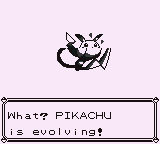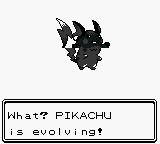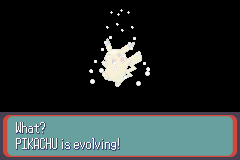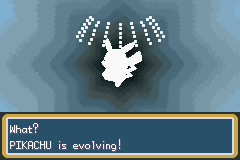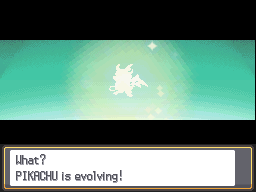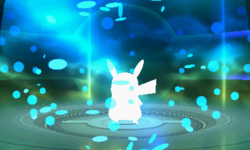Evolution: Difference between revisions
| Line 115: | Line 115: | ||
Pokémon that get [[Fainting|knocked out]] during a {{pkmn|battle}} will evolve at the end of that battle if its requirements have been met. However, before [[Generation VI]], losing a battle would make Pokémon not evolve even if the conditions have been met. | Pokémon that get [[Fainting|knocked out]] during a {{pkmn|battle}} will evolve at the end of that battle if its requirements have been met. However, before [[Generation VI]], losing a battle would make Pokémon not evolve even if the conditions have been met. | ||
Pokémon whose evolved forms are known in-game but not in its regional [[Pokédex]] will fail to evolve, even if the conditions have been met. In [[Pokémon FireRed & LeafGreen]], {{p|Chansey}}, a [[Generation I]] pokémon, will fail to evolve into {{p|Blissey}}, a [[Generation II]] pokémon, unless the national [[Pokédex]] is obtained. | |||
Pokémon that can evolve into more than one Pokémon will usually have the ways in which the evolution is activated being slightly similar, such as having both being initiated by [[evolutionary stone]] or by trading while [[held item|holding an item]]. Closely-related Pokémon, such as {{p|Nidoran♀}} and {{p|Nidoran♂}}, will also have very similar, if not identical, evolution methods. | Pokémon that can evolve into more than one Pokémon will usually have the ways in which the evolution is activated being slightly similar, such as having both being initiated by [[evolutionary stone]] or by trading while [[held item|holding an item]]. Closely-related Pokémon, such as {{p|Nidoran♀}} and {{p|Nidoran♂}}, will also have very similar, if not identical, evolution methods. | ||
Revision as of 21:07, 22 July 2018
- If you were looking for the set in the video game Pokémon Trading Card Game, see Evolution (GB1). For the expansion of the Pokémon Trading Card Game, see Evolutions (TCG).
Evolution (Japanese: 進化 evolution) is a process in which a Pokémon changes into a different species of Pokémon. This change is not merely visual, however, as Pokémon of a higher evolutionary stage have different (and usually more powerful) base stats than their predecessors, may have different moves that can be learned, and sometimes change their types, though usually at least one of the types of the previous form is preserved. Other statistics, such as Nature and EVs, as well as shininess, are preserved. With respect to real-world phenomena, Pokémon Evolution is more similar to metamorphosis than evolution. Evolution also appears to be a mostly independent phenomena from the aging process for most species, though Baby Pokémon need to evolve to their next stage in order to breed.
Professor Elm and Professor Rowan are the leading experts in Pokémon Evolution. According to the latter's research, over 90% of all Pokémon are connected to at least one other through Evolution (this is true only if Legendary Pokémon are excluded.) Rowan's research in Generation IV regards whether Evolution is a form of maturity in Pokémon, and looking at the implications of the process on Legendary Pokémon, which at that time did not evolve.
Evolution families
An evolution family is a group of Pokémon who will all, if bred with Ditto or a Pokémon in the same Egg Group, make a Pokémon Egg that will hatch into the same Pokémon, excluding baby Pokémon. This also means that the most basic form has the potential to become any of the rest of the family, although it will ultimately be able to follow only one evolutionary path.
Stages of evolution
Pokémon can be divided into different evolutionary stages, based on where they appear in their evolution family. All Pokémon fall into one of four groups: baby Pokémon, unevolved Pokémon, first-evolution Pokémon, and second-evolution Pokémon. These groups are also the basis for the TCG's grouping of Baby Pokémon, Basic Pokémon, Stage 1 Pokémon, and Stage 2 Pokémon, respectively.
Due to the fact that no evolution family contains both a baby Pokémon and a second-evolution Pokémon, many regard baby Pokémon as the most basic form, while moving their evolved counterparts one level higher. For example, originally, Pikachu was regarded as an unevolved Pokémon, however, with the release of Pichu in Generation II, many now consider it to be more on par with Pokémon like Charmeleon, though its TCG classification remains the same.
One-evolution families
- Main article: Pokémon that are part of a two-stage evolutionary line
By far the most common type of evolution family, these families are based in a Pokémon that will only ever evolve once in its development. About one third of all Pokémon that would later get a baby form were part of this kind of evolution family before their baby form was revealed. An example of this type of evolution family is below.
| |||||||||||
Two-evolution families
- Main article: Pokémon that are part of a three-stage evolutionary line
Perhaps the most well-known types of evolution families are those that feature two separate evolutionary events in the Pokémon's development. Indeed, this type of evolution family is what all of the starter Pokémon in the core series are a part of (excluding the starter Pikachu in Pokémon Yellow, as Pichu did not yet exist and it could not be evolved into Raichu; and Eevee, which could only be taken by Blue), as well as all pseudo-legendary Pokémon. An example of this type of evolution family is below.
| |||||||||||||||||
Pokémon that do not evolve
The least common type of evolution family is that in which no evolutionary event takes place, meaning that it is made up of only one member. Many of the Pokémon that have no evolutionary relatives are Legendary and Mythical Pokémon. However, there are still 75 other Pokémon that do not evolve.
Not belonging to an evolutionary family is not indicative of strength, or a lack thereof. Some Pokémon, such as Heracross and Skarmory, are comparable to fully evolved Pokémon while others, like Delibird and Luvdisc, are more comparable to unevolved Pokémon. Often this indicates a Pokémon's possibility to be eligible for future new evolutions or pre-evolutions.
Branched evolution families
- Main article: List of Pokémon with branched evolutions
Several families, while also one- and two-evolution families, are also branched evolution families. What this means is that there is a split in the evolutionary line at some point so that even though two Pokémon of the same species evolve the same amount of times, they can become one of two or more entirely different creatures. Eevee is the best-known example of this, evolving eight different ways depending on the method used. An example of this type of evolution family is below.
| |||||||||||||||||||
Methods of evolution
- Main article: Methods of evolution
The various triggers for a Pokémon's evolution are almost as varied as the Pokémon themselves, and some Pokémon have a unique evolution method. The most common of them is Evolution by leveling up at or above a certain level. Other methods include the following:
- leveling up when friendship has reached a high level (220 or greater)
- leveling up while holding an item
- leveling up while knowing a certain move or a move of a certain type
- leveling up in a certain location
- trading the Pokémon
- trading the Pokémon while holding an item
- trading the Pokémon for specific Pokémon
- using an evolutionary stone on it
- leveling up with a certain Pokémon or Pokémon of a certain type in the party
- leveling up while the Nintendo 3DS is upside-down
- level up or high friendship based on time of day
- level up a Pokémon during certain types of weather.
Additionally, holding an Everstone prevents a Pokémon from evolving, as well as surprising a Pokémon via the B Button. The latter method is known as an "Evolution cancel".
Pokémon that get knocked out during a battle will evolve at the end of that battle if its requirements have been met. However, before Generation VI, losing a battle would make Pokémon not evolve even if the conditions have been met.
Pokémon whose evolved forms are known in-game but not in its regional Pokédex will fail to evolve, even if the conditions have been met. In Pokémon FireRed & LeafGreen, Chansey, a Generation I pokémon, will fail to evolve into Blissey, a Generation II pokémon, unless the national Pokédex is obtained.
Pokémon that can evolve into more than one Pokémon will usually have the ways in which the evolution is activated being slightly similar, such as having both being initiated by evolutionary stone or by trading while holding an item. Closely-related Pokémon, such as Nidoran♀ and Nidoran♂, will also have very similar, if not identical, evolution methods.
Some Pokémon have different evolutions depending on their gender. For example, only female Combee can evolve into Vespiquen; male Combee cannot evolve at all. Meanwhile, all Snorunt can evolve into Glalie, but female Snorunt have the option of evolving into Froslass instead. This instance occurs in a similar way with Kirlia, albeit with males having split evolution instead.
Also, there have been situations in which the current party must be configured in a specific manner for some Pokémon to evolve. So far, only three Pokémon need to have these special requirements. Mantyke will evolve into Mantine if leveled up with a Remoraid in the player's party. Nincada will evolve into Ninjask when it reaches level 20. However, if there happens to be an empty space in the player's party (and a spare Poké Ball in Generation IV onward), a Shedinja will also appear in the party. Pancham evolves into Pangoro if its level is 32 or higher and there is a Dark-type Pokémon in the player's party.
Some Pokémon evolve in other unique ways. If one trades a Karrablast for a Shelmet, they will evolve into Escavalier and Accelgor, respectively, though neither will evolve if one of them holds an Everstone. When Inkay reaches level 30, the player must hold the 3DS upside-down for it to evolve into Malamar. Also introduced was a weather-based evolution: Sliggoo will evolve into Goodra beginning at level 50 only if it is raining in the area that the player is in. Finally, Sylveon can only be obtained by leveling up an Eevee that knows any Fairy-type moves and has at least two hearts of Affection.
In the side games
Hey You, Pikachu!
Some missions in Hey You, Pikachu! involve Pikachu interacting with other Pokémon in certain ways to cause their evolution. In Caring for Caterpie, the player and Pikachu supervise a group of Caterpie, who will evolve into Metapod and then Butterfree if treated well. In Field Trip, Pikachu can water wild Oddish and Gloom, causing them to evolve into Gloom and Vileplume, respectively.
Pokémon Colosseum and XD: Gale of Darkness
In Pokémon Colosseum and XD: Gale of Darkness, while evolution typically works as normal in the main series, Shadow Pokémon are incapable of evolving until they are purified and return to normal. In Pokémon XD: Gale of Dakrness, the player's Eevee is incapable of evolving into Espeon or Umbreon through normal methods, because the game does not have a Time mechanic. However, early in the game, the player is given their choice of evolution item to evolve it, including the Sun and Moon Shards, Key Items that will evolve Eevee into Espeon or Umbreon respectively after it levels up.
Pokémon Conquest
In Pokémon Conquest, because the mechanics of levels, experience, and friendship do not exist, Pokémon typically evolve once they reach a certain link threshold with their partnered Warrior or Warlord. Pokémon that normally evolve via high friendship in the main series games, such as Golbat, instead evolve after reaching a certain link percentage, usually between 60 and 70 percent. Pokémon that normally evolve at a set level instead evolve when a certain stat reaches a specific value. For example, Spheal evolves when its HP has reached a value of 138, which is partially determined by the link with its Warrior. Warriors with Pokémon that require an evolutionary stone to evolve must equip themselves with that item and then perform an action that causes their link to improve, such as completing a battle.
Pokémon Pinball series
In Pokémon Pinball and Pokémon Pinball: Ruby & Sapphire, the player can evolve Pokémon they caught in Catch 'Em Mode in a separate mode called Evolution Mode (EVO Mode in Pinball RS). In this mode the player selects an evolution-capable Pokémon in their possession, then guide their ball towards three symbols representative of their method of evolution in the main games, such as EX for Level evolution, or a Link Cable for Trade evolution. If the player collects the three symbols in time, they can bring their ball to the Center Hole to evolve their Pokémon, awarding them with their Pokédex entry and points.
Pokémon Mystery Dungeon series
In the Mystery Dungeon series, evolution is usually restricted until reaching the location where evolution is taking place. Evolution is typically done in a ritual held in several locations across the Pokémon world. Pokémon who evolve through unusual methods require an additional item to act as a catalyst.
In Red Rescue Team and Blue Rescue Team, evolution is held in Luminous Cave.
In Explorers of Time and Explorers of Darkness and Explorers of Sky, evolution is held in Luminous Spring. The player character and their partner may not evolve until they complete an additional scenario.
In Pokémon Mystery Dungeon (WiiWare) and Gates to Infinity, Pokémon can evolve as soon as they met the conditions. Due to the fact there is no special location to trigger evolution, evolution not based on items will happen similarly to core series, one attempt per level-up. Enemy Pokémon may evolve after defeating a member of the player's party.
In Super Mystery Dungeon, evolution is held in Tree of Life, with all but level requirements being removed (with the player being given choice for split evolutions). The player and their partner evolve into their final forms several times throughout the story. In addition, connectable Pokémon that exist as NPCs in this game and previous games will refuse evolution. However, because all Pokémon can be recruited separately through the Connection Orb, the player can still access their respective evolved forms in alternate ways. Certain enemies may evolve in specific conditions.
Pokémon Snap
In Pokémon Snap, the player can interact with Pokémon in certain ways that will make them evolve.
- At the end of Pokémon Island's Tunnel stage, if the player lures the three Magnemite together, they will fuse and become a Magneton.
- At the end of Volcano stage, if the player knocks a Charmeleon into the crater of magma it is circling around, it will evolve and come out as a Charizard.
- Luring a Slowpoke to a fishing area along the River will prompt it to fish with its tail, hooking a Shellder, causing it to evolve into Slowbro.
- Hitting the Grimer in the Cave three times with Pester Balls will cause it to evolve into Muk.
- In the Valley, completing a series of events will cause a Magikarp to evolve into Gyarados.
Pokémon GO
In Pokémon GO, the player can evolve Pokémon by spending Candy. The Candy cost for evolution varies between Pokémon species, ranging from 12 (to evolve Caterpie into Metapod) to 400 (to evolve Magikarp into Gyarados). In Pokémon GO, species that require a held item or Sun Stone to evolve in the core series also require that item to be spent in addition to Candy.
Each evolutionary family has their own kind of Candy. Candy can be obtained by catching or hatching Pokémon of that evolutionary family. The player can also obtain 1 Candy for its evolutionary family by permanently transferring it to Professor Willow.
Normally, Eevee evolves into Vaporeon, Jolteon, or Flareon at random. If Eevee is the current Buddy Pokémon, and has walked at least 10 km with the player and obtained at least two Candies, it will evolve into Espeon in day mode or Umbreon in night mode. However, if Eevee is nicknamed after one of the Eevee brothers (for Vaporeon, Jolteon, or Flareon) or the Kimono Girls in the anime (for Espeon and Umbreon), it will be guaranteed to evolve into the corresponding evolution, although this can only be performed once for each nickname.
Tyrogue evolves into Hitmonlee if Attack is its highest IV, Hitmonchan if Defense is its highest, and Hitmontop if HP is its highest. If there is a tie, it randomly evolves into one of the evolutions corresponding to its highest stat.
Feebas requires walking with it as a buddy Pokémon for 20km as a further requirement for its evolution to Milotic.
Wurmple has an equally random chance to evolve into either Silcoon or Cascoon.
Pokémon Duel
In Pokémon Duel, before a figure can evolve, the player must own both the pre-evolved figure and the evolved figure. The pre-evolved Pokémon must be set in the deck, and the evolved Pokémon must be set as that figure's evolution. During a duel, the pre-evolved Pokémon will be able to evolve when it wins a battle and either knocks out or displaces its battle opponent. Pokémon can also be evolved by the effects of Attacks, Abilities, and Plates. An evolved figure (including Mega Evolution) will receive +10 to its White and Gold Attacks and +1 ★ to its Purple Attacks. This boost stacks for a Pokémon that has evolved more than once.
In the anime

In the anime, Evolution happens in much the same way as it does in the games; though level-based evolutions and trade-based evolutions do not occur using those methods, there are similarities in the way they come about. For example, Misty's Poliwhirl evolved into Politoed because it found Ash's King's Rock and was holding it when Misty sent it out, while in the games it is required that Poliwhirl be traded while holding the King's Rock for the evolution to take place (it should be noted that Poliwhirl had been through a machine in connection with it being healed at the Pokémon Center, while holding the item). When a Beedrill attacked Ash's Metapod, it caused a crack to appear on its shell, which Butterfree came out of (although later examples of Metapod evolving into Butterfree were treated as the more familiar form of evolution used in the anime).
Additionally, a difference can be seen in the fact that Pokémon evolve during a battle, as opposed to after it. Pokémon may also evolve when they are needed to, for an extra boost of power or gaining new abilities, instead of after a set amount of training, such as when Ash's Charmeleon evolved into Charizard to battle an Aerodactyl just three episodes after it evolved from Charmander, where the game requires Charmeleon to grow twenty levels to reach that stage. In addition, Pokémon can sometimes choose not to evolve, even if they evolve by a 'natural' method such as leveling up. This was shown when Ash's Bulbasaur refused to evolve during an evolution festival for all Bulbasaur to evolve in Bulbasaur's Mysterious Garden. It appears that Evolution has emotional implications for Pokémon - some Pokémon, such as Team Rocket's Meowth, dislike their evolved forms, while others such as Ash's Pikachu simply want to prove they can be powerful without evolving. Conversely, when Pokémon do evolve, this can often be linked with an experience that causes them to mature emotionally or deal with an emotional issue, such as when the Poochyena in A Bite to Remember evolved, or the Paras in The Problem With Paras. Poochyena, for some reason, had an aversion to using the move Bite, while Paras was extremely timid and weak in battle. Both of them evolved shortly after overcoming these issues.
When a Pokémon begins to evolve, it will be enveloped by a brightly-colored light while slowly changing form; in the original, Advanced Generation, and Diamond & Pearl series, the light is simply white in color while in the Best Wishes and XY series, the light is blue in color. In the Sun & Moon series, different evolution effects were introduced depending on which Pokémon is evolving; for instance, when Mallow's Bounsweet evolved into Steenee, it shined pink and the physical changes that came with the evolution could be seen happening. Although some Pokémon returned to the old-style evolution effect (for instance, Sandygast into Palossand and Mareanie into Toxapex), others have been seen with completely new effects (notably Rockruff and Litten).
For a list of all evolutions that Pokémon belonging to the main cast have undergone, see List of anime Pokémon by evolution.
In the manga
Evolution is portray differently across manga adaptations. For example, in Pokémon Pocket Monsters, Pokémon are capable to evolve whenever they wish, and they revert to previous evolution stages. It seems that Pokémon can skip evolution stages as well, as is the case with Green's Charmander when it skips its Charmeleon stage and evolves directly into Charizard.
In the TCG
Evolution in the Pokémon Trading Card Game is very similar in some aspects to its counterpart in the core series. However, it differs mostly in the fact that there are no different methods needed to evolve a Pokémon, but instead, all Pokémon evolve simply by placing the next stage on top of a Pokémon in play that it evolves into.
Pokémon cannot be evolved on the first turn of the game or on the first turn they come into play. They also cannot be evolved if on the same turn they were previously evolved or devolved.
Stages of evolution
There are four different stages of evolution in the TCG, Baby Pokémon, Basic Pokémon, Stage 1 Pokémon, and Stage 2 Pokémon. Of these, only Baby and Basic Pokémon may be placed onto the Bench during the setup phase and during play; Stage 1 and Stage 2 Pokémon are considered to be evolution cards and therefore unable to be played except on top of their corresponding pre-evolved forms. The stage of evolution is indicated in a conspicuous place on each and every Pokémon card, though the placement differs among the four generations of cards.
Within the deck and discard pile, only Stage 1 and Stage 2 cards are considered to be "evolution cards" for the purpose of a Trainer card or Pokémon Power which allows them to be searched for. In play, a Basic Pokémon card can be considered an evolution card if it is evolved from its Baby stage.
Baby Pokémon
- Main article: Baby Pokémon
A Baby Pokémon is much the same in the TCG as it is in the core series of games. In fact, as with baby Pokémon released beyond Generation II, it is not even necessary for a Pokémon to even go through this stage of their evolutionary line, as the Pokémon can just start from their basic form. Baby Pokémon are among the weakest in the TCG, most often having 30 HP, as well as one of two special Poké-Bodys: one prevents all damage done to the Baby Pokémon while it is Asleep (Baby Pokémon with this Poké-Body also usually have an attack that changes their status to Asleep), and the other forces a Pokémon attempting to attack the Baby Pokémon to flip a coin, the attack doing nothing if that coin ends up tails.
Basic Pokémon
A Basic Pokémon is the most basic of Pokémon cards, as can be deduced from its name. Commonly basic Pokémon will have low HP, a common rarity, and low damage and Energy costs. These cards can be placed directly into play without another Pokémon card needing to be in play first. Pokémon that evolve from a Pokémon released in a later generation, such as Electabuzz or Pikachu, always are basic Pokémon, despite being the second Pokémon in their own evolutionary lines. Baby Pokémon, Shining Pokémon, Pokémon ![]() , Pokémon SP, and Pokémon-EX are always Basic, and the latter four cannot evolve.
, Pokémon SP, and Pokémon-EX are always Basic, and the latter four cannot evolve.
Stage 1 Pokémon
A Stage 1 Pokémon are the first kind of evolution card, being able to be evolved from a Basic Pokémon. Stage 1 cards are most commonly uncommon in rarity. Stage 1 Pokémon are also able to be Dark Pokémon and Light Pokémon.
Stage 2 Pokémon
A Stage 2 Pokémon is the highest of evolution cards, commonly rare or holographic in rarity, and can only, in normal conditions, be evolved from a Stage 1 Pokémon. Stage 2 Pokémon are also able to be Dark Pokémon and Light Pokémon.
Mega Evolution
- Main article: Mega Evolution
M Pokémon-EX cards were introduced in XY expansion and introduce the Mega Evolution mechanic featured in Pokémon X and Y. They are identified by a stylized ![]() graphic on the card name. M Pokémon-EX can only be played by Mega Evolving from basic Pokémon-EX. Doing so ends a players Turn immediately. Other than this, M Pokémon-EX share the same rules and design as regular Pokémon-EX and evolving Pokémon, with the addition of boosted Hit Points and more powerful Attacks.
graphic on the card name. M Pokémon-EX can only be played by Mega Evolving from basic Pokémon-EX. Doing so ends a players Turn immediately. Other than this, M Pokémon-EX share the same rules and design as regular Pokémon-EX and evolving Pokémon, with the addition of boosted Hit Points and more powerful Attacks.
Ability to evolve
A Pokémon card that is in the player's hand must say specifically that it evolves from a Pokémon card that is in play on the player's side. For example, Dark Blastoise states on the card "Evolves from Dark Wartortle". This means that any card named Dark Wartortle may be evolved into Dark Blastoise. However, a card simply named Wartortle cannot. Likewise, Pokémon such as Rhyhorn cannot be evolved into a Pokémon that says on it "Evolves from Team Magma's Rhyhorn".
However, Pokémon cards from different sets may evolve into one another. For example, Dark Crobat can evolve from either Dark Golbat of the Team Rocket set or Dark Golbat of the EX Team Rocket Returns set. So long as the card names match precisely both to (here Dark Crobat) and from (here Dark Golbat), the evolution is legal. This rule, of course, can be circumvented by certain means, such as Pokémon Powers and Trainer cards, however, this is not common.
In relation to the real world
Evolution in Pokémon is closer to the real-life phenomenon of metamorphosis rather than actual evolution, as real-life evolution happens to populations over a long period of time, not to individuals. In the Pokémon Adventures manga, it is mentioned that Pokémon Evolution is an entirely separate phenomenon from the normal process of evolution, and is a mysterious ability exclusive to Pokémon that is still not fully understood. In Pokémon Super Mystery Dungeon, it is described in the health class at the school in Serene Village as when a Pokémon's body rapidly grows larger with many other changes bringing a Pokémon closer to being an adult, being described akin to puberty.
Trivia
- Eevee and Feebas are the only two Pokémon that reach their next evolutionary forms in multiple ways. Whereas in the handheld games, Eevee becomes Espeon or Umbreon when leveled up with high friendship depending on the time of day, in Pokémon XD it evolves when leveled up with high friendship and the Sun Shard or Moon Shard in the Bag. This is because Pokémon XD, like Pokémon Colosseum and Pokémon FireRed and LeafGreen, lacks a time function. Feebas, meanwhile, evolves into Milotic when its Beauty condition is high, which cannot be done in the Generation V games or Pokémon X and Y unless the Feebas had its Beauty condition raised in Generation III, Generation IV, or Pokémon Omega Ruby and Alpha Sapphire previously. Due to this, the Prism Scale was introduced, so that Feebas caught in the wild or bred in Generation V onward would be able to evolve freely.
- Of all non-Legendary and non-Mythical Pokémon, 90.87% are part of an evolutionary line.
- Counting Legendary and Mythical Pokémon, 84.19% of all Pokémon are part of an evolutionary line.
- Generation III introduced the most Pokémon that do not evolve, with 18.
- In Generation VII, Alolan Pokémon and Pokémon that evolve into Alolan Pokémon have a different theme and a different colored background during evolution.
In other generations
In other languages
| ||||||||||||||||||||||||||||||||||||||||||||||||||||||||||||||||||||||
See also
| Pokémon training | |
|---|---|
| Catching • Nicknaming • Battling • Evolving • Trading • Breeding • Releasing | |

















